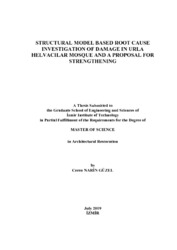Please use this identifier to cite or link to this item:
https://hdl.handle.net/11147/7445| Title: | Structural Model Besed Root Cause Investigation of Damage in Urla Helvacılar Mosque and a Proposal for Strengthening | Other Titles: | Urla Helvacılar Cami'ndeki Hasarın Temel Sebebinin Yapısal Model Bazlı Araştırılması ve Güçlendirme Önerisi | Authors: | Narin Güzel, Ceren | Advisors: | Kul Özdemir, Fatma Nurşen Aktaş, Engin |
Keywords: | Urla Helvacılar Mosque Conservation and restoration Cultural heritage |
Publisher: | Izmir Institute of Technology | Source: | Narin Güzel, C. (2019). Structural model besed root cause investigation of damage in Urla Helvacılar Mosque and a proposal for strengthening. Unpublished master's thesis, İzmir Institute of Technology, İzmir, Turkey | Abstract: | The period when small independent beyliks (principalities) were founded in
Anatolia in the 13th century is called the principalities period. The process of creating a
new architectural style in Western Anatolia, as well as the works-built marks an
important milestone in this period, which is defined as a transition period between the
Seljuk architecture and the Ottoman architecture. The Aydın Dynasty, one of the
important principalities of western Anatolia, had its capital at Birgi from 1308 to 1426.
The dynasty is known for with its economic and political power and the important
works it left behind.
Helvacılar Mosque is one of the important works of the Aydın Dynasty, which
was built in the 15th century and survives today. It is also an outstanding example to
understand the single-domed mosque typology in western Anatolia. Helvacılar Mosque,
located in the Kuşcular Neighborhood of the Urla District, is today derelict and
abandoned. Heavy structural damage in the structure poses a grave risk for the structure
to survive. This study compared and discovered the similarities and differences between
Helvacılar Mosque and the similar-period structures situated in Urla and identified the
architectural and structural characteristics of the structure with the aid of measured
drawing projects.
This study used a combination of architectural restoration and structural
engineering. For Helvacılar Mosque, the study carried out the self-weight analysis,
modal analysis, settlement analysis, response spectrum analysis, time history analysis
using three real earthquake records in a finite element model. The aim of engineering
research is to identify the present causes of damages in the structure.
With the help of finite element analysis, the study put forward the essential
repair and strengthening methods for Helvacılar Mosque to repair the damages observed
in the structure, strengthen the structure, and obviate the causes of the damages based
on the intervention methods offered in the guideline titled Earthquake Risk
Management of Historical Structures issued by the General Directorate of Foundations. 13. Yüzyılda küçük bağımsız beyliklerin kurulduğu zaman dilimi Beylikler Dönemi olarak adlandırılmıştır. Selçuklu mimarisi ile Osmanlı mimarisine arasında bir geçiş dönemi olarak tanımlanan bu dönemde; Batı Anadolu’daki yeni bir mimari üslup yaratma süreci ve ortaya çıkardıkları eserler önemli bir durak olarak kabul edilmektedir. Batı Anadolu’nun önemli beyliklerinden biri olan Aydınoğulları Beyliği 1308-1426 yılları arasında başkenti Birgi olan; dönemi içinde hem ekonomik ve politik gücüyle hem de bıraktığı önemli eserlerle anılan bir beyliktir. Helvacılar Cami 15. yüzyılda yapılmış ve günümüze ulaşan önemli Aydınoğulları eserlerinden biridir. Batı Anadolu’daki tek kubbeli cami tipolojisini anlamak için de önemli bir örnektir. Urla ilçesinin Kuşçular Mahallesi’nde bulunan Helvacılar Cami, günümüzde metruk ve terk edilmiş durumdadır. Yapıdaki ağır strüktürel hasarlar, yapının ayakta kalması açısından büyük risk yaratmaktadır. Bu çalışma; Helvacılar Cami’nin Urla’da bulunan benzer dönem yapıları ile karşılaştırarak yapılar arasındaki benzerlikleri ve farklılıkları belirlenmekte ve çalışma yapısının mimari ve yapısal özelliklerini hazırlanmış rölöve projeleri yardımıyla tanımlamaktadır. Mimari restorasyon ve yapı mühendisliği alanlarının ortaklaştırılması ile hazırlanan bu çalışmada, Helvacılar Cami’nin hasarsız sonlu elemanlar modeli ile kendi ağırlığı altında analizi, modal analizi, oturma analizi, tepki spektrumu analizi ve üç adet gerçek deprem kaydı ile zaman tanım alanında analizleri yapılmıştır. Mühendislik çalışmalarındaki amaç; yapıdaki mevcut hasar sebeplerinin neler olduğunu tespit edebilmektir. Sonlu eleman analizlerinin de yardımıyla; yapıda gözlemlenen hasarların onarılması, yapının güçlendirilmesi ve hasarlara yol açmış sebeplerin ortadan kaldırılması amaçlı Vakıflar Genel Müdürlüğü’nün Tarihi Yapılar için Deprem Risklerinin Yönetimi isimli kılavuzundaki müdahale yöntemleri esas alınarak Helvacılar Cami için gerekli onarım ve güçlendirme yöntemleri ortaya konmuştur. |
Description: | Thesis (Master)--Izmir Institute of Technology, Architectural Restoration, Izmir, 2019 Includes bibliographical references (leaves: 114-117) Text in English; Abstract: Turkish and English |
URI: | https://hdl.handle.net/11147/7445 |
| Appears in Collections: | Master Degree / Yüksek Lisans Tezleri |
Files in This Item:
| File | Description | Size | Format | |
|---|---|---|---|---|
| T001920.pdf | MasterThesis | 38.55 MB | Adobe PDF |  View/Open |
CORE Recommender
Page view(s)
244
checked on Apr 14, 2025
Download(s)
88
checked on Apr 14, 2025
Google ScholarTM
Check
Items in GCRIS Repository are protected by copyright, with all rights reserved, unless otherwise indicated.